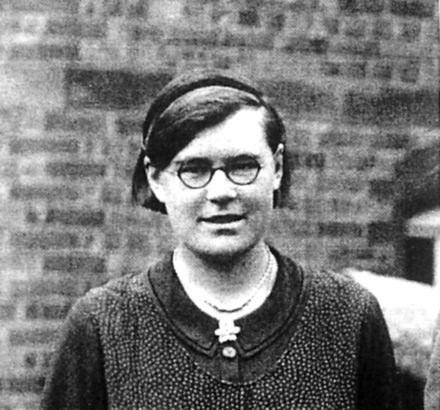Geologist and science writer Nina Morgan describes a surprise double wedding
Morgan, N., Marriage of true minds. Geoscientist 30 (1), 26, 2020
https://doi.org/doi: 10.1144/geosci2020-067, Download the pdf here

She was a talented botanist who went on to study botany and geology in 1903 at University College London – 'The Godless Place in Gower Street' – under the supervision of the botanist Francis W. Oliver [1864 – 1951] and the geologist, Thomas George Bonney [1833 – 1924]. He was a palaeobotanist, appointed by Professor Thomas McKenny Hughes [1832 - 1917] in 1899 to a demonstratorship in the Woodwardian (later Sedgwick) Museum in Cambridge
The pair, Edward Alexander Newell Arber [1870 – 1918] and Agnes Robertson [1878 – 1960], met while she was an undergraduate at Newnham College, Cambridge. They fell in love, and became engaged in 1906.
Image: Muriel Arber, Edward and Agnes' daughter, in about 1936
The absent-minded professor
They were married in Cambridge in 1909. Thanks to Bonney, who was also an ordained minister, their union was 'doubly blessed'. As their daughter, Muriel Arber [1913 – 2004] described it:
"Professor Bonney returned to Cambridge, and as a friend of both my parents he officiated at their wedding. Indeed he married them with great thoroughness, for not being in the habit of conducting the service, he accidentally went back instead of forward after the vows, so that my father twice endowed my mother with all his worldly goods as she for the second time promised to love, honour and obey him... Professor Bonney then gave a charming little address in which he said that the happiest marriages the he knew were those in which the man and woman remained lovers." Bonny, himself, never married.
The wedding gifts, too, were unusual:
"I still have the wedding present that the Curator of the [Sedgwick] Museum, Henry Keeping, then aged 82, gave to my parents: it is a box containing some excellent fossil specimens of his own collecting, lying on pink cotton wool: Belemnites oweni, split to show the phragmacone, together with a pair of interlaced crayfish from the Wealden, and a fine palatine tooth of a Cretaceous fish. Pasted on a piece of cardboard was a little poem on love cut out of the Daily Chronicle."
Academic riches
Demonstrators were poorly paid, and in the early days of the marriage money was tight. It was, Muriel recalls, 'only [Newell's] consulting fees that made the marriage in 1909 possible... I owe my own existence to the Kent Coalfield later on.'
But in the academic sense, the Arbers were very rich. Before his early death, Newell wrote more than 6 monographs on palaeobotany and geology, published the book, The Natural History of Coal, and more than 90 papers and articles. He later became well known for his studies of the geomorphology of the Devon coast described in his book, The Coast Scenery of North Devon, published in 1911, which inspired Muriel's own research on geomorphology.
Her mother went on to become a plant morphologist and anatomist, as well as a historian and philosopher of botany. She was elected a Fellow of the Royal Society in 1946, the first female botanist and only the third woman to receive that honour.
Muriel graduated from Newnham College, Cambridge in Geology (BA 1935, MA 1938), and from 1942 – 1973 taught at The King's School in Ely. She played a central role in the Geologists' Association, where she served as President from 1972 – 1974, and was a key architect of the GA Code for Geological Fieldwork. She also carried out research on fossil brachiopods and published a series of papers on the geomorphology, with special reference to sea-level change, cliff profiles and active land slipping on the coasts of South Devon and Dorset.
Love affair
In 1922 Muriel fell in love with Lyme Regis where she "found the key to the whole future of my life." Though Cambridge-based she visited Lyme often. She was, said the late John Fowles, 'the genius of the place' who provided the geological background for his novel, The French Lieutenant's Woman. But an even higher accolade came from the local newspaper, which towards the end of her life dubbed her 'Lyme's Oldest Tourist'!
End notes: Sources for this vignette include: Papers of Edward Alexander Newell Arber at https://archiveshub.jisc.ac.uk/data/gb590-arbr ; Obitiuary of E.A. Arber, Geol.Mag, 5, 426-341, 1918 Obituary of Muriel Agnes Arber by Eric Robinson, Proc. Geol. Assoc. 116, 61-63, 200; Early Memories of the Sedgwick by Muriel Arber, GeoCam, 7, 5-7, 2003 and personal memories provided by Eric Robinson.
Nina Morgan is a geologist and science writer based near Oxford. Her latest book, The Geology of Oxford Gravestones, is available via www.gravestonegeology.uk